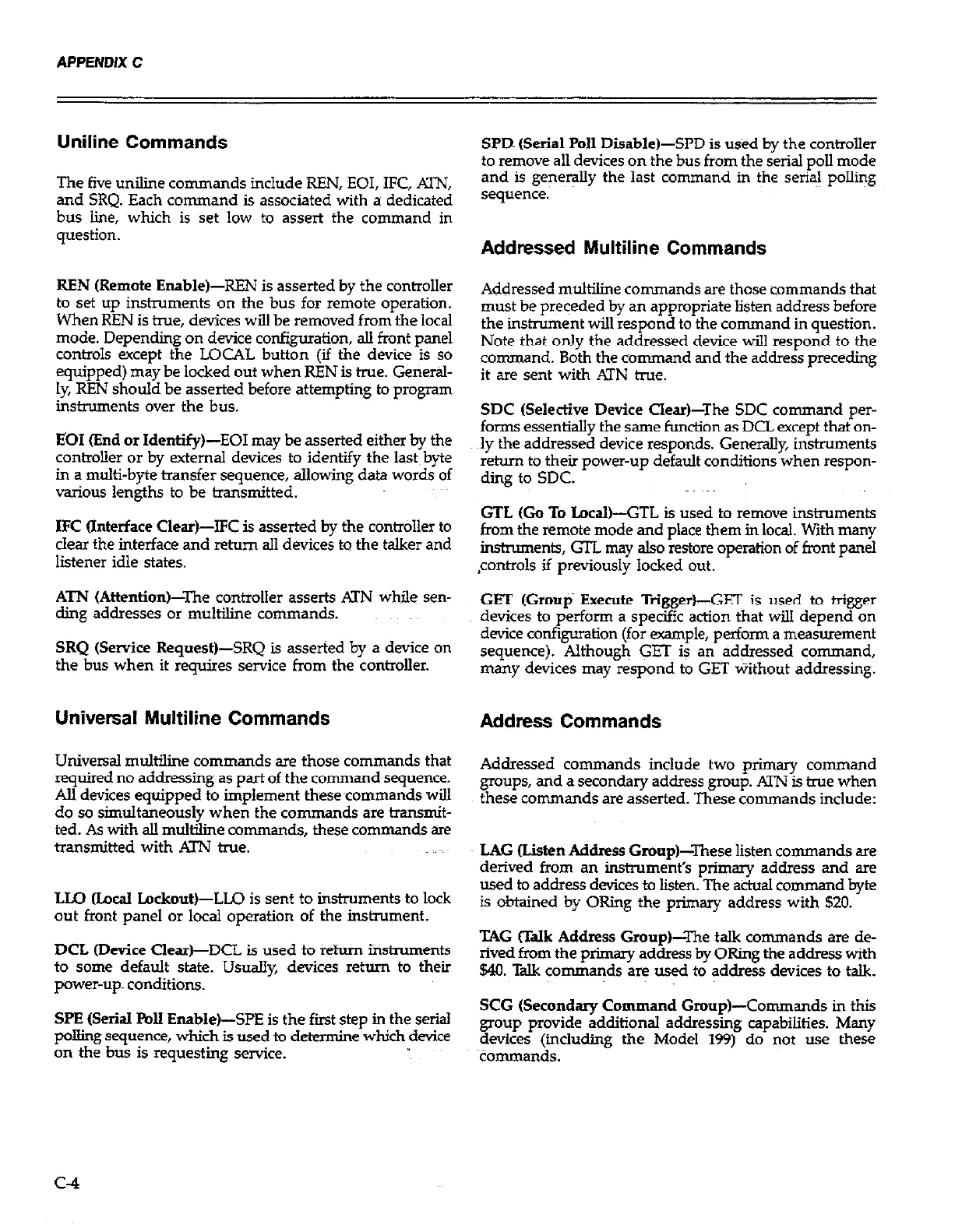APPENDIX C
Uniline Commands
The five uniline commands include REN, EOI, IFC, ATN,
and SRQ. Each command is associated with a dedicated
bus lie, which is set low to assert the command in
question.
REN (Remote Enable)-REN is asserted by the controller
to set up inshuments on the bus for remote operation.
When REN is true, devices will be removed from the local
mode. Depending on device configuration, all front panel
controls except the LOCAL button (if the device is so
equipped) may be locked out when REN is true. General-
ly, REN should be asserted before attempting to program
instruments over the bus.
EOI (End or Identify)-EOI may be asserted either by the
controller or by external devices to identify the 1as.t~ byte
in a multi-byte transfer sequence, allowing data words of
various lengths to be transmitted.
IFC (Interface Clear)-IFC is asserted by the controller to
clear the interface and return all devices to the talker and
listener idle states.
ATN (Attention)-The controller asserts ATN while sen-
ding addresses or multiline commands.
SRQ (Service Request)-SRQ is asserted by a device on
the bus when it requires service from the controller.
Universal Multiline Commands
Universal multiline commands are those commands that
required no addressing as part of the command sequence.
All devices equipped to implement these-commands will
do so simultaneously when the commands are transmit-
ted. As with all multiline commands, these commands are
transmitted with ATN true.
LLO (Local Lockout)-LLO is sent to instruments to lock
out front panel or local operation of the instrument.
DCL (Device Clear)-DCL is used to return iiistruments
to some default state. Usually, devices return to their
power-upon conditions.
SPE (Serial poll Enable)-SPE is the first step in the serial
polling sequence, which is used to determjne which device
on the bus is requesting service.
SPD~ (Serial Poll Disable)-SPD is used by the controller
to remove all devices on the bus from the serial poll mode
and is generally the last command in the seri$ polling
sequence.
Addressed Multiline Commands
Addressed multiline commands are those commands that
must be preceded by an appropriate listen address before
the instrument will respond to the command in question.
Note that only the addressed device will respond to the
command. Both the command and the address preceding
it are sent with ATN true.
SDC (Selective Device Clear)-The SDC command per-
forms essentially the same function as DCL except that on-
sly the addressed device responds. Generally, instruments
return to their power-up default conditions when respon-
ding to SDC.
GTL (Go To Local)-GTL is used to remove instruments
from the remote mode and place them in local. With many
instruments, GTL may also restore operation of front panel
~controls if previously locked out.
GET (GroqY Execute Trigged-GET is used to trigger
devices to perform a specific action that will depend on
device configuration (for -pie, perform a measurement
sequence). Although GEX is an addressed command,
many devices may respond to GET Without addressing.
Address Commands
Addressed commands include two primary command
groups, and a secondary address group. ATN is true when
these commands are asserted. These commands include:
LAG (Listen Address Group)-These listen commands are
derived from an instrument’s primary address and are
used to address devices to listen. The actual command byte
is obtained by ORing the primary address with 520.
TAG Walk Address GroupH’he talk commands are de-
rived from the primary address by ORing the address with
$40. Talk commands are used to address devices to talk.
SCG (Secondary Command Gmup)-Commands in this
group provide additional addressing capabilities. Many
devices (including the Model 199) do not use these
~tommands.
C-4

